Censorship and Vandalism: The Art of Harmony Hammond
Censorship and Vandalism: The Art of Harmony Hammond
L. Strong: Censorship & Vandalism
In her book Lesbian Art in America, Harmony Hammond writes that she has “always tried to work on the edge between abstract form and political content.” They come together in two one-person shows featuring her art this fall: Erasing Censorship, on view September 1 through October 22 at Left Coast Books Gallery in Goleta, California, and Against Seamlessness, on view October 15 through November 26 at Dwight Hackett Projects in Santa Fe, New Mexico.
The California exhibit’s name is more overtly political, especially coming a year after the gay and lesbian art world was rocked by the removal of a video by gay artist David Wojnarowicz from the Smithsonian’s National Portrait Gallery show of gay portraits, under pressure from fundamentalists in Congress upset by a clip that showed ants crawling on a crucifix. Gay and lesbian artists staged protests and wrote letters to the National Portrait Gallery, while other venues around the country offered to host the exhibition. Hammond was part of those protests, but her California show centers on other forms of censorship.
The first is self-censorship. When working on Lesbian Art in America, a handful of artists wrote letters to Hammond refusing to allow their work to appear in the book. She believed such self-censorship contributed to the ongoing cultural erasure of lesbian art and artists and decided to “presence these artists in their absence.” In her Small Erasure series, Hammond photocopied the letters from artists denying her the right to reproduce their art in the book, crossing out or erasing their names and other information that would reveal their identities and covering the photocopies with skin-like latex rubber that makes them look washed out and difficult to decipher.
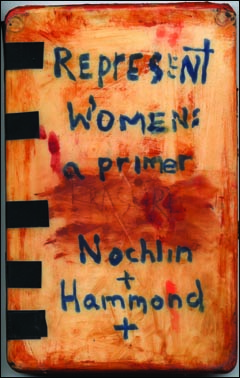 The second form of censorship Hammond explores is vandalism. In 2001 over 600 books in the San Francisco Public Library, most with LGBT or feminist subject matter, were found severely damaged. The perpetrator was caught and convicted of a hate crime, but the city’s library system and LGBT community found its own creative way to counter the vandalism: the damaged books were given to artists in San Francisco and to a smaller group in and around Santa Fe who transformed them into works of art. The art was sold, with proceeds used to purchase new copies of the books.
The second form of censorship Hammond explores is vandalism. In 2001 over 600 books in the San Francisco Public Library, most with LGBT or feminist subject matter, were found severely damaged. The perpetrator was caught and convicted of a hate crime, but the city’s library system and LGBT community found its own creative way to counter the vandalism: the damaged books were given to artists in San Francisco and to a smaller group in and around Santa Fe who transformed them into works of art. The art was sold, with proceeds used to purchase new copies of the books.
Hammond “repurposed” two damaged books for this project, the results of which are included in Erasing Censorship. One was Linda Nochlin’s Representing Women, a Marxist analysis of the representation of women in nineteenth-century French painting, whose back half had been sliced off. Hammond “reconstituted” the book with a protective layer of latex rubber, as a way of reconstituting the images of women’s bodies. She titled the piece Represent Women: A Primer.
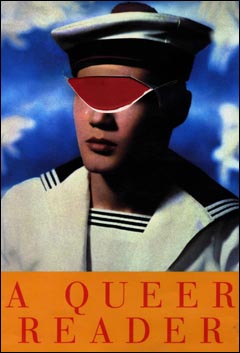 The second was A Queer Reader: 2500 Years of Male Homosexuality, an anthology of writings by gay male authors. The book jacket incorporated the photograph Le Marin (The Sailor) by Pierre et Gilles, the French photographic duo known for their homoerotic images. The vandal had cut out the sailor’s eyes. Hammond made a digitized print of the damaged jacket cover without the subtitle or editor’s name so that it simply read A Queer Reader. With the focus now on the violently vandalized sailor, Hammond evokes the mythological theme of blinding, often read psychoanalytically as a symbol of sexual mutilation. Hammond also repurposed the book’s interior pages, from which the vandal had carved out eye-shaped holes. She created a suite of “portraits” of seven famous gay male authors—Oscar Wilde, E. M. Forster, W. H. Auden, Jean Genet, Tennessee Williams, Ned Rorem, and Allen Ginsberg—by positioning sexually suggestive text from their writing in the frames of the eyeholes, asserting the authors’ continuing presence after the destruction caused by the vandalism.
The second was A Queer Reader: 2500 Years of Male Homosexuality, an anthology of writings by gay male authors. The book jacket incorporated the photograph Le Marin (The Sailor) by Pierre et Gilles, the French photographic duo known for their homoerotic images. The vandal had cut out the sailor’s eyes. Hammond made a digitized print of the damaged jacket cover without the subtitle or editor’s name so that it simply read A Queer Reader. With the focus now on the violently vandalized sailor, Hammond evokes the mythological theme of blinding, often read psychoanalytically as a symbol of sexual mutilation. Hammond also repurposed the book’s interior pages, from which the vandal had carved out eye-shaped holes. She created a suite of “portraits” of seven famous gay male authors—Oscar Wilde, E. M. Forster, W. H. Auden, Jean Genet, Tennessee Williams, Ned Rorem, and Allen Ginsberg—by positioning sexually suggestive text from their writing in the frames of the eyeholes, asserting the authors’ continuing presence after the destruction caused by the vandalism.
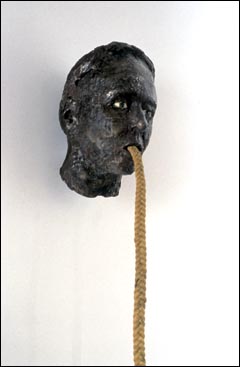 Erasing Censorship also includes two visually powerful bronze sculptures: Speaking Braids, a female head placed high on a wall with a hemp braid falling from her mouth onto a book-like slab of wax on the floor, and Untitled (Head), a head, resting on its side on a small cart, that looks like it’s gasping for its last breath. Censorship, the two pieces imply, is an attack not just on artistic freedom but on the breath of life itself.
Erasing Censorship also includes two visually powerful bronze sculptures: Speaking Braids, a female head placed high on a wall with a hemp braid falling from her mouth onto a book-like slab of wax on the floor, and Untitled (Head), a head, resting on its side on a small cart, that looks like it’s gasping for its last breath. Censorship, the two pieces imply, is an attack not just on artistic freedom but on the breath of life itself.
Hammond’s other show this fall, Against Seamlessness, at first glance seems to resist such overt political interpretation. The pieces, with titles like Flap, Muffle, Red Bed, Buff, Dark, Sienna, Little Buff, and Buffer, are aggressively abstract and nearly monochromatic. Their textured and often luminous surfaces are beautiful to the eye but apparently opaque to the world of ideas outside aesthetics. But just scratch their surfaces, so to speak, and their underlying content emerges. In her 2010 Manifesto (Personal) Of Monochrome (Sort Of), Hammond writes that
While these paintings engage with (and, I like to think, interrupt and resist) the history of modernist painting—and more specifically, narratives of abstraction and monochrome—they come out of post-minimal and feminist concerns with materials and process rather than modernist reduction.
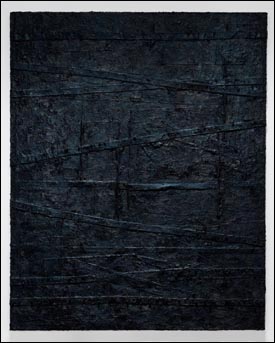
They are formal, frontal, reductive, condensed. They resist pictorial space and assert the painting object. But they also invite content. My work is NOT pure, isolated, authoritative, universal, self-referential, self-sufficient, or removed from social function. I invoke references and associations. I welcome the world outside the painting edge into the painting field.
This may sound highly cerebral, but it’s simply a theoretical framework for something very fundamental to Hammond’s work even at its most abstract, a visceral effect evoked by the “references and associations” embedded in the art. She describes this as follows in Lesbian Art in America: “For me the painting skin, that edge where art and life literally meet, always relates to the gendered body as site. To layer strokes of paint is to accumulate, to build on the body. To caress. To incise into the painting surface is to cut into the body.” Hammond’s approach to painting is dynamic and sensual. As art historian Julia Brian-Wilson notes in the foreword to the catalog for Against Seamlessness:
To encounter one of these works is to perform an act of excavation—to uncover Hammond’s muscular process, to glimpse her building up the hues, to discover past layers leaking out from between small fissures. They are visibly labored paintings: they have been worked on and worked over….They inspire a kind of erotic longing—grommet holes to finger, blacks that glisten. Vivid to the point of being lively, they have an animate quality: in Red Bed, the canvas is trussed with strips that crisscross it as if to lash it down.
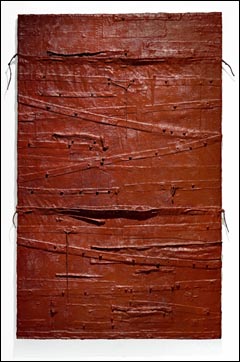 Hammond’s paintings are not mere intellectual exercises but reach for the bleeding, mucky, passionate center of what it means to be alive. They aim to communicate the complex nature of our humanity, both physical and mental, sometimes in conflict with itself, always striving to surpass its own limitations.
Hammond’s paintings are not mere intellectual exercises but reach for the bleeding, mucky, passionate center of what it means to be alive. They aim to communicate the complex nature of our humanity, both physical and mental, sometimes in conflict with itself, always striving to surpass its own limitations.
As a feminist, Hammond has long been concerned about the right of women to exercise their abilities and pursue their dreams in a way that men take for granted. In particular, she has long been concerned about the place of women in art; her earlier work, for example, cross-pollinated fine art and traditional women’s crafts such as weaving and rug-making. But in her monochromes, something different is going on. They speak to how both men’s and women’s bodies are not just sexually constituted but are sites of the physical, cultural, and psychological dimensions of being human.
“Seamlessness” suggests sealing off, a lack of openness—a realm of absolutes and conformism. In fact, it’s related to Hammond’s concerns about censorship, whose aim is to produce a deadening political and social uniformity and to squelch diversity, dissension, and the general messiness of human life. Hammond’s protean art ranges from word art to constructions to sculpture to complex paintings, but it’s unified by the vision of a world where cultural and political diversity, the gendered body, and even bodily processes are embraced. As curators Dwight and Jenifer Hackett of the Santa Fe show put it, “She creates boundaries, she pushes boundaries. She invites us to transcend both the artistic and the political into a new understanding of who we are.”
For more about the exhibitions, visit Left Coast Books and Dwight Hackett Projects. For more on Harmony Hammond’s art, visit her website.
Lester Strong is the special projects editor for A&U magazine. He is a regular contributor to the Gay and Lesbian Review, and his writings on the visual, written, and performing arts have appeared in many publications, including Out magazine, the New Mexico Historical Review, and the South Dakota Review.
Images:
Represent Women: A Primer, 2002. Mixed media, 6 1/4 inches by 10 inches by 3/4 inch. Art©Harmony Hammond/VAGA, NYC. Courtesy Dwight Hackett Projects, Santa Fe. Collection of Richard Meyer.
A Queer Reader, 2003. Archival inkjet print, 66 3/4 inches by 44 inches. Art©Harmony Hammond/VAGA, NYC. Courtesy Dwight Hackett Projects, Santa Fe.
Speaking Braids (detail), 2000-2002. Bronze, acrylic, hemp, and wax, 83 inches by 22 inches by 22 inches. Art©Harmony Hammond/VAGA, NYC. Courtesy Dwight Hackett Projects, Santa Fe.
Muffle, 2009. Oil and mixed media on canvas, 98 1/8 inches by 79 1/2 inches. Art©Harmony Hammond/VAGA, NYC. Courtesy Dwight Hackett Projects, Santa Fe.
Red Bed, 2011. Oil and mixed media on canvas, 80 1/2 inches by 50 1/2 inches (exclusive of strings). Art©Harmony Hammond/VAGA, NYC. Courtesy Dwight Hackett Projects, Santa Fe.






